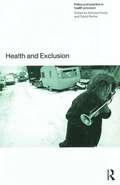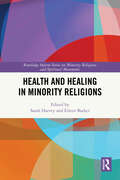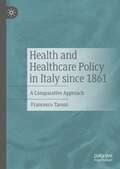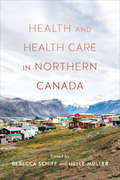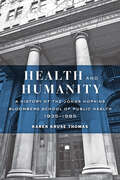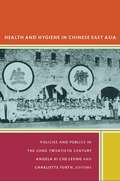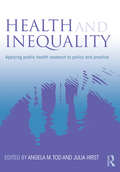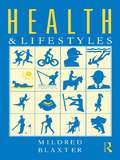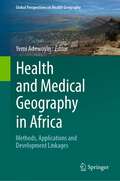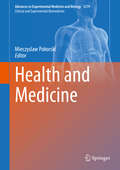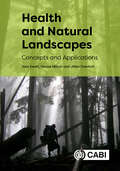- Table View
- List View
Health and Exclusion: Policy and Practice in Health Provision
by David Banks Michael PurdyHealth and Exclusion is a pioneering examination of those policies and practices of exclusion currently experienced by health 'customers' in the UK. Chapters document examples of exclusion in a number of controversial areas, including: *the impact of poverty on the health of children *exclusion in maternity care *exclusion of those with mental health problems *exclusion of the elderly in health care *the silenced voice of the patient *barriers to recruitment and advancement within the health professions. The authors challenge whether New Labour policies sufficiently address the inequalities in health experienced by some sectors of society. Moreover they suggest that health professionals at times actively contribute to exclusion and suggest strategies and practices to combat marginalisation and resist exclusion.
Health and Gender: Resilience and Vulnerability Factors For Women's Health in the Contemporary Society
by Anita Riecher-Rössler Ilaria TarriconeThis book presents a concise and comprehensive overview of the most important protective and risk factors for women's health, and reviews the main areas of medical science from a gender perspective. Numerous scientific experiments and studies have shown how gender differences significantly affect the clinical presentation of physical and mental health disorders as well as responses to treatments. This text highlights these issues, while at the same time reflecting on the practical implications of the theoretical knowledge presented. It also examines the organization of social and health services, which should increasingly take into account the specificities related to gender differences and where equality is based on truly embracing these differences. The final part provides insights into the experiences and testimonies collected by the authors of the book. Written by a multidisciplinary team of medical, psychosocial and humanities professionals, this book is of interest to health professionals and medical students.
Health and Healing in Minority Religions (Routledge Inform Series on Minority Religions and Spiritual Movements)
by Eileen BarkerThis volume explores the diversity of beliefs and practices around health and healing in minority religions from different perspectives. The contributors include academics from a variety of disciplines as well as members of minority religions. The introductory chapter focuses on the metaphors and meanings that religions use to indicate their understandings of the body and its boundaries and concepts of health and healing. Chapters follow on the concepts of health and healing in the Jehovah’s Witnesses, Christian Science, Panacea Society, Pentecostal Christianity, Paganism, Lubavitcher Hasidim and Daesoon Jinrihoe, amongst others. Other chapters focus on contemporary yoga, the Gisu of Uganda, the psychology of believers in alternative medicine and the French government’s opposition to alternative healing practices. The book will be useful for academics and students of religious studies, especially those interested in minority religions and alternative healing practices.
Health and Healing in the Early Modern Iberian World: A Gendered Perspective (Toronto Iberic)
by Sarah E. Owens Margaret E. BoyleRecognizing the variety of health experiences across geographical borders, Health and Healing in the Early Modern Iberian World interrogates the concepts of "health" and "healing" between 1500 and 1800. Through an interdisciplinary approach to medical history, gender history, and the literature and culture of the early modern Atlantic World, this collection of essays points to the ways in which the practice of medicine, the delivery of healthcare, and the experiences of disease and health are gendered. The contributors explore how the medical profession sought to exert its power over patients, determining standards that impacted conceptions of self and body, and at the same time, how this influence was mediated. Using a range of sources, the essays reveal the multiple and sometimes contradictory ways that early modern health discourse intersected with gender and sexuality, as well as its ties to interconnected ethical, racial, and class-driven concerns. Health and Healing in the Early Modern Iberian World breaks new ground through its systematic focus on gender and sexuality as they relate to the delivery of healthcare, the practice of medicine, and the experiences of health and healing across early modern Spain and colonial Latin America.
Health and Health Promotion in Prisons
by Michael RossThe impact of the United Nations "Healthy Prisons" initiative has highlighted the importance of health and health promotion in incarcerated populations. This invaluable book discusses the many health and medical issues that arise or are introduced into prisons from the perspective of both inmates and prison staff. Health and Health Promotion in Prison places key issues in prison healthcare into a historical perspective and investigates contemporary policy drivers. It then addresses the significant legal issues relating to health in prison settings and the human rights implications and questions that arise. The book presents a useful framework for health education in prison and a model for introducing structural, policy and health-related changes based on the UN Health in Prisons model, and also includes a special chapter on mental health issues. Providing a comprehensive and thought-provoking overview of health promotion issues in correctional environments, this is an essential reference for all those involved in prison healthcare.
Health and Healthcare Policy in Italy since 1861: A Comparative Approach
by Francesco TaroniProviding a historical overview of healthcare in Italy from its unification in 1861 to the present COVID-19 pandemic, this book analyses the political, social and cultural impact of Italian healthcare policy and medicine. The author examines the development of public health, hospitals, and primary care, and the building of healthcare systems across three political regimes in Italy: the liberal period (1861-1914), Fascism (1922-43), and the Italian Republic (1948 to the present day). By emphasising the embeddedness of health-related legislation in Italy’s political and social background, this book offers a comparative account of Italian health policy, and contrasts this with developments in neighbouring European countries, Canada and the United States. The book focuses on the Italian government’s reaction to the social and political impact of several diseases: pellagra; cholera; malaria; and tuberculosis, and explores the present-day response to the current COVID-19 pandemic. A timely and comprehensive read, this book will appeal to those teaching and researching Italian history and the history of medicine and healthcare more widely.
Health and Healthcare in Complexity: 3P Ecosystems for Collaborating, Adapting and Leading Change
by Sandra Jones Dein Vindigni OamThis book unveils the transformative potential of the 3P Ecosystem Framework for Collaborative Health Partnerships, offering a comprehensive guide to designing and implementing sustainable health solutions for complexity. Through an ecological lens, complemented by a distributed leadership approach, this volume addresses contemporary health challenges and provides empirical evidence from diverse case studies. The chapters delve into the need for a holistic, collaborative approach exploring critical topics such as how to adapt and lead change that is inclusive of practitioners and patients, indigenous health practices and the use of digital health innovation to support transnational health partnerships. Expert contributors present a blend of theoretical insights and practical applications, making this book an essential resource for understanding and navigating the complexities of modern health ecosystems. Readers will discover how to foster collaboration that builds capacity and promotes self-determination in various health contexts. Ideal for academics, students, practitioners, and policymakers in health professions, social sciences, business, and leadership, this book offers valuable tools, resources and frameworks for creating adaptable and equitable health solutions. Whether you are involved in mainstream or community health provision or international health collaborations, this volume provides the knowledge and resources needed to drive impactful change.
Health and Healthcare in Northern Canada
by Rebecca Schiff and Helle MøllerAccounting for almost two-thirds of the country’s land mass, northern Canada is a vast region, host to rich natural resources and a diverse cultural heritage shared across Indigenous and non-Indigenous residents. In this book, the authors analyse health and health care in northern Canada from a perspective that acknowledges the unique strengths, resilience, and innovation of northerners, while also addressing the challenges aggravated by contemporary manifestations of colonialism. Old and new forms of colonial programs and policies continue to create health and health care disparities in the North. Written by individuals who live in and study the region, Health and Health Care in Northern Canada utilizes case studies, interviews, photographs, and more, to highlight the lived experiences of northerners and the primary health issues that they face. In order to maintain resilience, improve the positive outcomes of health determinants, and diminish negative stereotypes, we must ensure that northerners – and their cultures, values, strengths, and leadership – are at the centre of the ongoing work to achieve social justice and health equity.
Health and Humanity: A History of the Johns Hopkins Bloomberg School of Public Health, 1935–1985
by Karen Kruse ThomasThe mid-twentieth-century evolution of the Johns Hopkins School of Public Health.Between 1935 and 1985, the nascent public health profession developed scientific evidence and practical know-how to prevent death on an unprecedented scale. Thanks to public health workers, life expectancy rose rapidly as generations grew up free from the scourges of smallpox, typhoid, and syphilis. In Health and Humanity, Karen Kruse Thomas offers a thorough account of the growth of academic public health in the United States through the prism of the oldest and largest independent school of public health in the world. Thomas follows the transformation of the Johns Hopkins School of Hygiene and Public Health (JHSPH), now known as the Bloomberg School of Public Health, from a small, private institute devoted to doctoral training and tropical disease research into a leading global educator and innovator in fields from biostatistics to mental health to pathobiology.A provocative, wide-ranging account of how midcentury public health leveraged federal grants and anti-Communist fears to build the powerful institutional networks behind the health programs of the CDC, WHO, and USAID, the book traces how Johns Hopkins helped public health take center stage during the scientific research boom triggered by World War II. It also examines the influence of politics on JHSPH, the school’s transition to federal grant funding, the globalization of public health in response to hot and cold war influences, and the expansion of the school’s teaching program to encompass social science as well as lab science.Revealing how faculty members urged foreign policy makers to include saving lives in their strategy of "winning hearts and minds," Thomas argues that the growth of chronic disease and the loss of Rockefeller funds moved the JHSPH toward international research funded by the federal government, creating a situation in which it was sometimes easier for the school to improve the health of populations in India and Turkey than on its own doorstep in East Baltimore. Health and Humanity is a comprehensive account of the ways that JHSPH has influenced the practice, pedagogy, and especially our very understanding of public health on both global and local scales.
Health and Hygiene in Chinese East Asia: Policies and Publics in the Long Twentieth Century
by Angela Ki Che Leung Charlotte FurthThis collection expands the history of colonial medicine and public health by exploring efforts to overcome disease and improve human health in Chinese regions of East Asia from the late nineteenth century to the present. The contributors consider the science and politics of public health policymaking and implementation in Taiwan, Manchuria, Hong Kong, and the Yangzi River delta, focusing mostly on towns and villages rather than cities. Whether discussing the resistance of lay midwives in colonial Taiwan to the Japanese campaign to replace them with experts in "scientific motherhood" or the reaction of British colonists in Shanghai to Chinese diet and health regimes, they illuminate the effects of foreign interventions and influences on particular situations and localities. They discuss responses to epidemics from the plague in early-twentieth-century Manchuria to SARS in southern China, Singapore, and Taiwan, but they also emphasize that public health is not just about epidemic crises. As essays on marsh drainage in Taiwan, the enforcement of sanitary ordinances in Shanghai, and vaccination drives in Manchuria show, throughout the twentieth century public health bureaucracies have primarily been engaged in the mundane activities of education, prevention, and monitoring. Contributors. Warwick Anderson, Charlotte Furth, Marta E. Hanson, Sean Hsiang-lin Lei, Angela Ki Che Leung, Shang-Jen Li, Yushang Li, Yi-Ping Lin, Shiyung Liu, Ruth Rogaski, Yen-Fen Tseng, Chia-ling Wu, Xinzhong Yu
Health and Inequality: Applying Public Health Research to Policy and Practice
by Angela M. Tod Julia HirstHow can research on the social determinants of health be translated into real life public health practice? Challenging the research-practice gap, this text shows readers from a range of professions how their practice can help to minimise health inequalities. The social model of health embraces individual lifestyles, social and community networks, socio-economic, political and cultural influences and the plethora of factors that can impact on public health, for instance, education, work, welfare benefits, environment, housing, health and social care. All of these can have a significant effect on people’s experiences of health and well-being, and are often unrecognised sources of health inequalities. This innovative textbook outlines and discusses key public health principles and the social model of health. Drawing on a range of case studies and the international literature, it looks at how public health research has been applied to policy and practice. The book discusses the transferability that these findings have had and their capacity to influence and provide evidence for practice. Health and Inequality covers a broad range of social determinants of health, encountered throughout the life-course, including: Pre-birth and early years Breastfeeding and teenage mothers Health inequalities for mothers and babies in prison Children in full time education Sexuality, relationships and sexual health of young people Early adulthood Welfare rights and health benefits Women, employment and well-being Adults in later life Practical and clearly structured, this text will be useful to a range of health and social care professionals involved in public health work, particularly those undertaking courses on public health, health promotion or the social determinants of health.
Health and Lifestyles
by Mildred BlaxterWhat is a `healthy' lifestyle? Which is more significant: the social circumstances in which people live, or lifestyle habits such as exercise or smoking? Health and Lifestyles is the first description of a large and representative survey of the British population asking just those questions. It examines the findings, and considers issues such as measured fitness, declared health, psychological status, life circumstances, health-related behaviour, attitudes and beliefs. Providing firm evidence of the importance of social circumstances and patterns of health-related behaviour, Health and Lifestyles is an important contribution to current debate, revealing the levels of inequality in health in Britain today.
Health and Medical Aspects of Ramadan Intermittent Fasting
by Osama Hamdy Ahmed S. BaHammam MoezAlIslam E. Faris Mohamed M Hassanein Hamdi ChtourouThe Definitive Guide to Ramadan Fasting & Health - From Leading Experts. Discover the groundbreaking science behind Ramadan intermittent fasting with "Health and Medical Aspects of Ramadan Intermittent Fasting," the first book of its kind. Edited by five renowned scientists with hundreds of published research works in this particular area of research, this comprehensive resource brings together the insights of eminent researchers in the field. Explore 19 in-depth chapters covering the diverse health and medical dimensions of this significant practice. A must-have for healthcare professionals, researchers, and anyone seeking a scientifically sound understanding of Ramadan fasting.
Health and Medical Geography in Africa: Methods, Applications and Development Linkages (Global Perspectives on Health Geography)
by Yemi AdewoyinThis contributed volume focuses on the evolution and current state of the sub-discipline of health and medical geography in Africa. It encompasses theoretical and methodological issues as well as the current teaching and research capacities of institutions offering programs in health and medical geography in Africa. Further, the book will review the level of adoption of the sub-discipline in State policies and practice and also provide practical illustrations, with case studies, of how studies in the sub-discipline are central to the actualization of Africa's development agenda. Particular attention is paid to the relationship between health and development. Through its direct and indirect impacts on labor productivity, population health and wellbeing matter for the social and economic development of households and national economies. Yet, health is not uniform in space. And so is development. Comparatively on many health and development indicators, Africa fairs poorly. The variation in health may present as differences in the occurrence and spread of diseases, the distribution of and access to healthcare facilities, and/or in health outcomes among the population. Reasons for these variations range from biology to the population’s levels of exposure and susceptibility to elements in their environment, including the social interactions taking place within the environment. The field of health and medical geography focuses on the spatial patterns and processes underlying these variations and provides pathways for understanding and addressing them. More specifically, the sub-discipline of health and medical geography focuses on, among others, how places (their characteristics and processes that go on in them) and environmental factors underlie and/or influence disease patterns, exposure and susceptibility to diseases, health variations, health behavior, health outcomes, and the provision of and access to healthcare services. This volume documents perspectives and applications in health and medical geography in Africa for academics, students, health practitioners, and development policymakers.
Health and Medical Geography, Fourth Edition
by Elisabeth Dowling Root Margaret Carrel Michael EmchWhy are rainfall, carcinogens, and primary care physicians distributed unevenly over space? The fourth edition of the leading text in the field has been updated and reorganized to cover the latest developments in disease ecology and health promotion across the globe. The book accessibly introduces the core questions and perspectives of health and medical geography and presents cutting-edge techniques of mapping and spatial analysis. It explores the intersecting genetic, ecological, behavioral, cultural, and socioeconomic processes that underlie patterns of health and disease in particular places, including how new diseases and epidemics emerge. Geographic dimensions of health care access and service provision are addressed. More than 100 figures include 16 color plates; most are available as PowerPoint slides at the companion website. New to This Edition: *Chapters on the political ecology of health; emerging infectious diseases and landscape genetics; food, diet, and nutrition; and urban health. *Coverage of Middle East respiratory syndrome, Ebola, and Zika; impacts on health of global climate change; contaminated water crises in economically developed countries, including in Flint, Michigan; China's rapid industrial growth; and other timely topics. *Updated throughout with current data and concepts plus advances in GIS. *A range of pedagogical features. Pedagogical Features: *End-of-chapter review questions and suggestions for further reading. *Section Introductions that describe each chapter. *"Quick Reviews"--within-chapter recaps of key concepts. *Bold-faced key terms and an end-of-book glossary.
Health and Medicine
by Ross M. MullnerThis volume in The SAGE Reference Series on Disability explores health and medical issues for people with disabilities. It is one of eight volumes in the cross-disciplinary and issues-based series, which incorporates links from varied fields making up disability studies as volumes examine topics central to the lives of individuals with disabilities and their families. With a balance of history, theory, research, and application, specialists set out the findings and implications of research and practice for others whose current or future work involves the care or study of those with disabilities, as well as for the disabled themselves. The concise, engaging presentational style emphasizes accessibility. Taken individually, each volume sets out the fundamentals of the topic it addresses, accompanied by compiled data and statistics, recommended further readings, a guide to organizations and associations, and other annotated resources, thus providing the ideal introductory platform and gateway for further study. Taken together, the series represents both a survey of major disability issues and a guide to new directions and trends and contemporary resources in the field as a whole.
Health and Medicine (Advances in Experimental Medicine and Biology #1279)
by Mieczyslaw PokorskiThis book offers a reliable source of information on the latest advances and current trends in the medical and clinical sciences. The focus is on certain fields that are of consistently high practical interest due to widespread disease morbidity, and on pathomechanisms that are not yet fully understood and their treatment. The topics covered include, but are not limited to, the search for novel biomarkers of colorectal cancer, morbidity and mortality after traumatic brain injuries, and impairment in brain-controlled muscle mechanisms after stroke. In addition, problematic issues in pulmonary medicine are discussed at length. These issues, notably, concern human studies that have set the standards for allergy, sensory irritation, and sensitization research, as well as studies on the management and treatment of chronic obstructive pulmonary disease and obstructive sleep apnea. Lastly, the book addresses various aspects of commonplace viral respiratory infections, such as vulnerability and transmission in both pediatric and adult populations, flue vaccination coverage, and post-infectious respiratory complications. . The book’s goal is to promote the restoration and maintenance of good health, disease prophylaxis, and improved patient management by integrating research into clinical work and findings on improving care. It offers a valuable asset for clinical specialists, researchers, and everyone engaged in healthcare.
Health and Natural Landscapes: Concepts and Applications
by Professor Denise Mitten Dr Alan W Ewert Dr Jillisa OverholtNatural landscapes are intricately tied to human health and well-being. While contemporary lifestyles have caused people to feel disconnected from the natural environment, this relationship is now recognized as vitally important, with landscapes increasingly valued for their stress-reduction, aesthetic, and restorative benefits. Providing an overview of the history, theoretical concepts, and individual and societal implications of human connection to natural landscapes, this book considers natural landscapes' role as an antidote to our modern, predominantly urban society. It also delivers: - A robust, research-backed overview of the intersections between natural landscapes and human health; - A compendium of applications such as nature-based therapies, urban greenspaces, and adventure-based programming that promote health within specific populations of society and individuals; - Due consideration of crucial factors that can adversely affect health and landscape, such as climate change. Of critical importance as we continue to define the role that natural landscapes will play for future generations, this book should be required reading for policy makers, urban planners and industry practitioners. It provides a thorough grounding in understanding the intersections between health and natural landscapes, and will be a valuable resource for academicians and students from a broad range of disciplines including public health, leisure and tourism, environmental sciences, and geography.
Health and Numbers
by Chap T. LeLike its two successful previous editions, Health & Numbers: A Problems-Based Introduction to Biostatistics, Third Edition, is the only fully problems-based introduction to biostatistics and offers a concise introduction to basic statistical concepts and reasoning at a level suitable for a broad spectrum of students and professionals in medicine and the allied health fields. This book has always been meant for use by advanced students who have not previously had an introductory biostatistics course - material often presented in a one-semester course - or by busy professionals who need to learn the basics of biostatistics. This user-friendly resource features over 200 real-life examples and real data to discuss and teach fundamental statistical methods. The new edition offers even more exercises than the second edition, and features enhanced Microsoft Excel and SAS samples and examples. Health & Numbers, Third Edition, truly strikes a balance between principles and methods of calculation that is particularly useful for students in medicine and health-related fields who need to know biostatistics.
Health and Nutrition of Women and Children in Empowered Action Group States of India: Status and Progress
by Sandhya R Mahapatro, Udaya S Mishra and Shubh SwainThis book tracks the progress of maternal and child health (MCH)—part of SDG3—in empowered action group states in India. It lays bare regional disparities and unfolds a range of issues relating to inequalities in access to MCH services, complex dynamics behind poor nutrition, health expenditure and impoverishment, structural bottlenecks of health system that hinder effective implementation of programmes; best practices adopted for improving MNCH indicators and appropriate strategies required for more informed policy. The volume: Examines the changing features of health and nutrition of mothers, new-borns and children between pre and post National Rural Health Mission (NRHM) Studies reproductive health and well-being of mother and children Explores linkages between food, nutrition and health Examines the underlying factors determining poor health and nutrition Probes into health expenditure, their impoverishment and its bearing on access to maternal and child healthcare services Proposes strategic interventions to reduce maternal, neonatal and child mortality and improve nutritional status The volume will be of great interest to scholars and researchers of public health, especially maternal and child health specialists, gender studies, development studies and public policy.
Health and Poverty
by Michael J. Holosko Marvin D. FeitUnequal social and health care policies in the United States continue to keep the poor disempowered in situations that not only limit their access to health care services, but also the quality of care they receive. An overview of health policies in the U.S., Health and Poverty examines where gaps in social and health care policies exist at the federal, state, and municipal levels; the impact of economic recessions on health care; and how our health policies are inextricably linked with political agendas, economic priorities, and social and cultural values.In an attempt to bridge issues of health, such as health care and administration costs, with issues of social and health policy related to poverty in America, this important book explores the need to make fundamental change to the structure of the medical and health care system. It contends that the incremental modifications our government has taken have not changed regional and economic disparity, granted equal access to services or equal quality of care, or eliminated discrimination. Providing the political and economic context for understanding health care policy issues and concerns related to the poor, Health and Poverty discusses: services and programs that achieve more humane outcomes why our cultural values present the greatest challenge toward developing competent, accessible, and affordable health care for all U.S. residents barriers to health care for the homeless population with HIV patient dumping how many African-American infants and children lack access to primary care physicians or services how the U.S. focuses on who receives medical care, rather than on how medical care is delivered and received trends in states’Medicaid programs the impact of poor working conditions on the physical and emotional health of low-income minority populationsAs Health and Poverty demonstrates, universal health care can only become a reality in the U.S. when reform proposals that divide the public into the “deserving” and the “undeserving” are rejected. Health care is not a privilege, reserved for the middle class and the wealthy. It is a basic human right. Social workers, policymakers, health care educators and providers, and public administrators need to read this book to find out how that right can be guaranteed to all Americans and why current legislation and health care reform proposals are inadequate for meeting the health care needs of countless men, women, and children.
Health and Poverty: Global Health Problems and Solutions
by Gijs WalravenThere is growing interest and concern about the unacceptable differentials in health between and within countries. This comes out of the realization that poor people will only be able to prosper, and emerge from poverty, if they enjoy better health. Healthy populations are a precondition for sustainable development. Using a novel combination of the personal studies of patients and description of conditions or diseases, this book provides a highly original and accessible introduction to key issues in global health today. Especially during the past decade, global health initiatives have become a prominent part of the international aid picture, bringing new resources, political commitment, and more attention for international health issues in the media. The author provides examples of diseases and problems related to health that disproportionally impact the poor, and gives their experiences 'a human face' through individual case studies. A specific case study of a health problem, such as malaria, tuberculosis and HIV or health financing, introduces each chapter and is followed by a historical review of the problem, why it is still now a problem for poor people or poor countries, and what can be done about it. These will inspire the reader to become more engaged with international health and development.
Health and Prosperity: Efficient Health Systems for Thriving Nations in the 21st Century
by Fabrice MurtinMurtin examines the long-term causes of health improvements over the last two centuries. Focusing on the relative importance of income and education, Murtin finds that education alone accounts for the bulk of health improvements since 1870, and explains the strong correlation between longevity and income, which is highly correlated with education. Conversely, the book shows that progress in longevity has had dramatic consequences on societies, as it reduced fertility, triggered the spread of education, spurred economic growth, and improved 'prosperity' in a way that is comparable to the long-term rise in income. Health and Prosperity sheds light on the real cost of health systems in the 21st century.
Health and Safety Communication: A Practical Guide Forward
by Richard E. Miller David S. AndersonHealth and Safety Communication: A Practical Guide Forward is an easy introduction to the principles and practice of health and safety communications, providing all you need to know to design and implement communications efforts on a wide range of health and safety topics and issues. Whether you're a student grappling with a health communications course or a professional wishing to learn how to communicate health and safety messages effectively to a range of audiences using a variety of communications media, Health and Safety Communication is all you'll need. This book incorporates two broad sections: the grounding and the applications. The model articulates a planning approach for designing, implementing and reviewing a range of communications approaches. The applications segment specifies numerous approaches, including workshops, print materials, campaigns, the media, public speaking and social media that can be used to convey what the health and safety specialist wants the audience to "know, feel and do" as a result of engagement with the communications approach. Health and Safety Communication blends sound foundations with practical strategies for health and safety communication so that messages can be communicated more effectively; after all, for changes to occur, the message must be received and respected. Unique features of this book include a wide range of approaches and strategies, with numerous examples and tips provided throughout. "Messages from the field" incorporate examples and samples from over 30 individuals and organizations, offering their insights and suggestions. The applied approach of this definitive guide is designed to enhance the competence and confidence of those currently in health or safety arenas, as well as those seeking to incorporate health or safety messages in other settings such as businesses or communities.
Health and Safety in Contemporary Britain: Society, Legitimacy, And Change Since 1960
by Mike Esbester Paul AlmondThis book analyses the perceived legitimacy of health and safety in post-1960 British public life. Since 2010 health and safety has appeared to be in crisis, being attacked by press, politicians and public alike, but are these claims of crisis accurate? How have understandings of health and safety changed over the past 60 years? By exploring the history, culture, and operation of health and safety in contemporary Britain, this book provides a new assessment of an understudied, but surprisingly far-reaching, part of the British political and social landscape. Combining archival research with focus group, social survey and oral history testimony, the book examines the historical background to health and safety, how health and safety has been enacted in public and in the workplace, the impact of changing economic, occupational and social structures on the operation of health and safety, and the conflicts and interests that have shaped the area.
